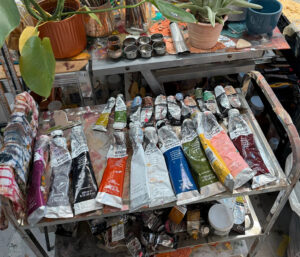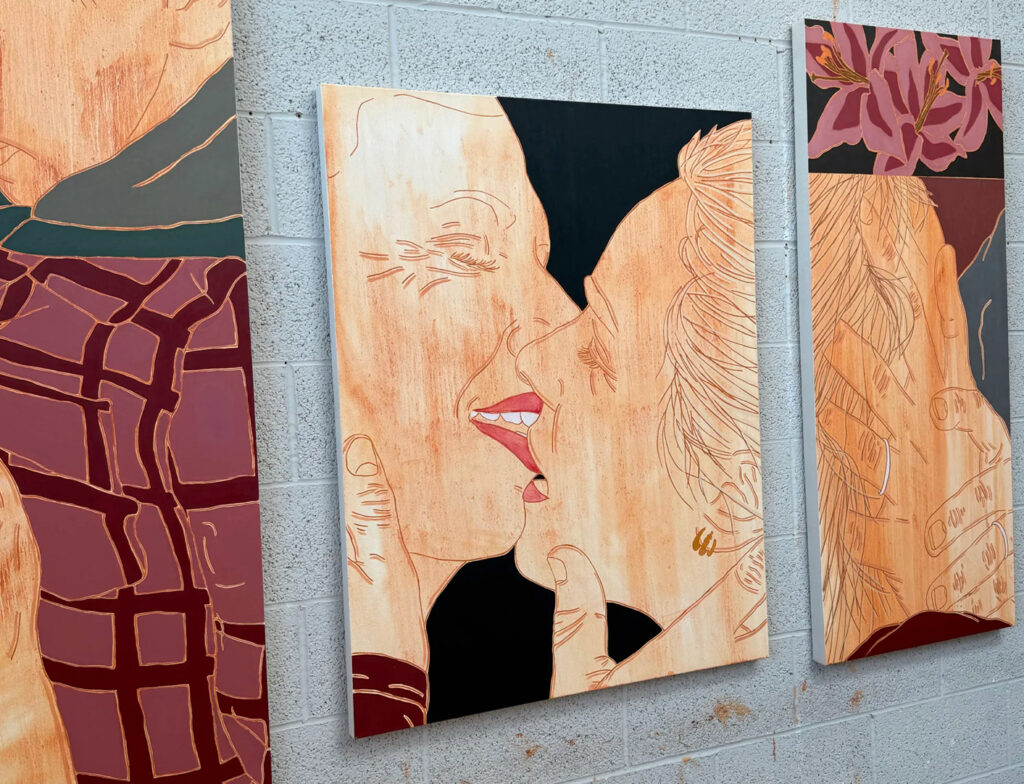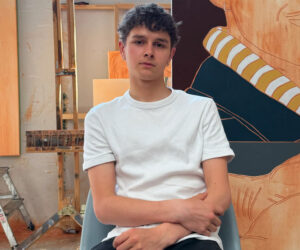
By the age of 22, most artists are still finding their footing—experimenting, oscillating between imitation and instinct, searching for an honest line. But Isaac Andrews has been making art long enough to shed precocity and lean into purpose. Nearly a decade into his career, the London-born painter is not simply navigating the art world; he’s redrawing its expectations. His works have already entered major private collections. He’s been tapped by Miu Miu, shown at Frieze, and captured the attention of critics who speak of him not as a young artist, but as a necessary one. And yet, for all the attention, there’s a sense that Andrews is just beginning.
To say Andrews is a rising star is to miss the point. He doesn’t rise—he hovers. He refracts. His presence in the art world feels spectral, less of a meteoric arrival and more of a long, deliberate seep into the conversation. His canvases hum with silence. His palette shifts like breath. He is not here to perform youth. He is here to remind us that seriousness doesn’t require age—just vision.
The Apprenticeship of Attention
Andrews began painting at 14, a time when most are still caught between adolescence and the algorithms of identity. He started not with grand statements or forced iconoclasm, but with curiosity. “I wanted to see if I could slow something down,” he said in an interview last year, “and painting was the only thing that didn’t move too fast.”
That instinct—to decelerate, to dwell—is perhaps the defining ethos of his work. His early pieces, often centered on intimate portraiture, betrayed a precocious ability to capture quiet. But more than talent, they revealed discipline. While others chased virality, Andrews chased weight. He was never concerned with capturing attention. He was interested in holding it.
His self-guided education in the arts—part YouTube, part autodidactic rigor, part apprenticeship with older creatives—was never linear. But it was immersive. He painted constantly. He studied oils like scripture. He spent hours in the National Gallery not photographing works for clout, but parsing the brushwork. Andrews built a studio practice rooted in repetition, not recognition.
A Language of Skin and Smoke
Today, Andrews’ style is difficult to pin down—and that’s intentional. His work resists categorization while drawing from an evident lineage of Black portraiture, abstraction, and British figuration. There are echoes of Lynette Yiadom-Boakye in his character studies, Barkley L. Hendricks in his attention to presence, and Francis Bacon in the way form sometimes warps under emotion.
His subjects are often alone—still, private, unaware of being observed. But Andrews doesn’t render them with voyeurism. He paints as though he knows them, or wants to. The brushwork is gestural but controlled. Faces blur at the edges, suggesting motion or memory. In some works, the eyes are unfinished, hauntingly absent. In others, they meet you full on.
His use of color is both restrained and radiant. Smoke tones, umbers, steel blues, ochres—he favors a muted spectrum, but within it, there is heat. Andrews isn’t interested in spectacle. He’s interested in residue. His paintings often feel like what’s left after something has happened—after the subject has wept, or smoked, or whispered, or listened. They are never empty. They are filled with afterthought.
Studio Practice as Ritual
Though his age often leads to headlines, Andrews conducts his studio practice with the seriousness of a veteran. He wakes early, paints daily, and spends hours “just looking.” His East London workspace is sparse but meticulous—canvases stacked, light pouring in through high windows, the smell of turpentine and linen always lingering.
Music plays a central role in his process: classical during sketching, ambient while layering oils, rap when stepping back to critique. “Painting’s like rhythm,” he once said. “You don’t always have to be loud. You just need to know where the silence goes.”
He stretches his own canvases, mixes many of his pigments, and favors brushes worn down by time. The materiality of his practice matters. For Andrews, painting isn’t performative—it’s devotional.
Tapped by Fashion, Rooted in Art
It was Miu Miu that first tapped Andrews for a high-profile collab, featuring his painted works and sketchbook fragments in their Spring/Summer 2024 campaign. The partnership was a turning point—not in his career trajectory, which was already quietly ascending, but in how wider culture began to frame him. Suddenly, he was not just an emerging painter, but an artist with crossover cachet.
But rather than pivot toward a lifestyle brand or commercial art direction, Andrews returned to canvas. He was flattered by the visibility, sure. But he didn’t mistake it for validation. “Fashion’s great,” he said. “But paint dries slower.”
He remains cautious of hype cycles, especially in an industry hungry to crown the next it painter. “I’m not interested in becoming a headline,” he told a UK publication. “I’m trying to build something slow and permanent. Something with weight.”
The Market Sees, But Does It Understand?
Isaac Andrews’ paintings are already in the hands of major collectors, from London to Lagos. He’s been included in Frieze week showcases and invited to speak on panels about the future of contemporary Black British art. But commercial interest has never dictated his pace. In fact, he paints slower now than ever.
Critics have praised his restraint. Others, more cynically, worry he might be playing the market—deliberately withholding to build mystique. But such readings feel dismissive of the sincerity that radiates from his work. Andrews doesn’t withhold. He waits. There is a difference.
His pricing, like his output, is thoughtful. He refuses to flood the market. He offers works sparingly, often to buyers who express understanding rather than status-seeking. “I don’t want my work to hang where it won’t be looked at slowly,” he once told a gallerist. That sentiment alone marks him as rare.
London, Always
Though his work travels, Andrews remains rooted in London. The city is in his breath, in his cadence, in the smokiness of his palette. East London especially haunts his work—the rhythm of the Tube, the murk of the Thames, the faded signage of old corner shops. He paints not landmarks but atmospheres.
And while his themes are global—grief, intimacy, memory, longing—his textures feel local. The fog, the rust, the diffused light. His London isn’t a skyline. It’s a feeling.
What Comes Next?
There is talk of a solo exhibition, tentatively titled “Shadow Studies”, scheduled for late 2025. He’s been experimenting with larger formats, incorporating textiles, and even exploring sculptural elements. But don’t expect spectacle. Expect refinement.
Andrews is not interested in overreaching. He’s interested in deepening. “I’m still trying to get one face right,” he said recently. “I want to paint something that doesn’t need a caption.”
He has also expressed interest in teaching—not as a career pivot, but as a form of reciprocal generosity. He often credits mentors who took time for him when he was just a 16-year-old with oil-stained jeans and a sketchbook full of half-finished eyes. Now, he wants to pass that lineage forward.
A Decade Deep, and Still Becoming
To describe Isaac Andrews as “promising” feels wrong. It implies that his worth lies in a future version of himself. But he is already here—fully formed, deeply present, and quietly reordering the terms of what it means to be a young painter in 2025. His work doesn’t explode. It lingers. It watches back. It waits.
And in a world addicted to acceleration, perhaps what we need most is an artist like Andrews—someone who dares to slow the frame, to honor the unfinished, to find beauty not in noise but in nuance.
Because some paintings don’t ask to be liked.
They ask to be seen.
No comments yet.









